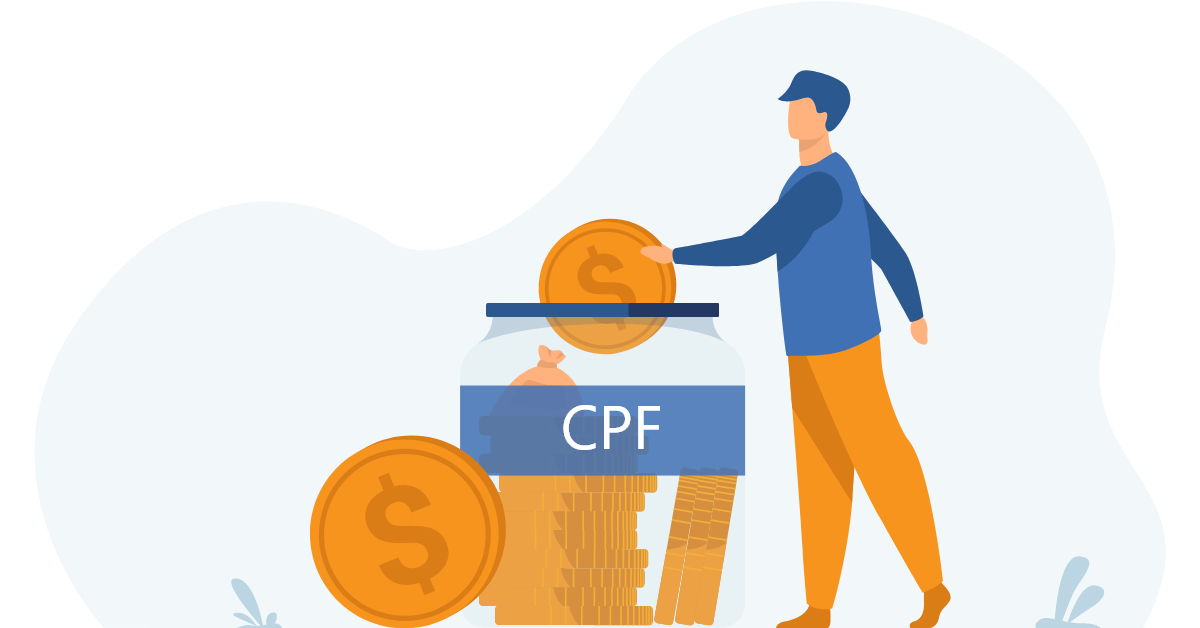CPF Contribution Guide for Companies in Singapore

3 min Read
In Singapore, every employee who is a permanent resident is entitled to CPF contributions made by their employers and themselves. Therefore, if you plan to set up a company in the city-state, you must understand the CPF since you will also be responsible for contributing one.
This article will further talk about how CPF contributions work in Singapore.
What is CPF?
CPF stands for Central Provident Fund and is one of the most common funds in Singapore. It functions as a comprehensive social security system that allows employees working in Singapore to set aside funds for their retirement. In addition, this fund also financially supports the community to handle health care, homeownership, or purchase assets through profitable schemes.
Under the CPF scheme, all Singaporeans are required to make regular contributions to the fund, which invests the proceeds on their behalf for their future benefits. Moreover, both citizen or PR employers and employees should also contribute to this fund every month.
Who is responsible for making CPF contributions?
CPF contributions are payable to citizens and permanent residents (PR) of Singapore who:
- Work in Singapore on a service contract;
- Employed permanently, part-time, or casually.
However, if the employee is a citizen or PR working overseas, the CPF contribution is not mandatory.
How does the CPF contribution work?
Each eligible Singaporean will have their CPF account to which these contributions are deposited. Like bank savings accounts, these deposits earn interest, allowing account holders or CPF members to nurture their money.
Singaporean employees contribute to CPF by having a portion of their salary deducted by their employers each month at a set percentage. However, to contribute to the fund, they must earn more than S$50 per month.
Likewise, employers in Singapore must pay into their employees’ CPF accounts out of their own pocket, above and beyond their stipulated salaries. In addition, employers are entitled to recover the employees’ share from their employees’ wages if they earn more than $500 per month.
Types of CPF accounts
All Singaporeans and PRs have the following CPF accounts, which are opened to hold money for several purposes:
-
- Ordinary Account (OA): You can use this account for housing, higher education, and investing.
- Special Account (SA): This account can be used for old age and retirement-related investments.
- Medisave Account (MA): Singaporeans can use this account to pay for hospitalization, other approved medical expenses, and MediShield/Integrated Shield plans.
- Retirement Account (RA): You only get RA when you are 55 years old. Your OA and SA will merge to form your RA at that age, which will contain your retirement savings.
CPF contribution rates for Singaporean employees/employers
For salaried employees, CPF contributions are made automatically every month. Therefore, employees’ take-home or actually-received salaries are lower than the official salaries stated in their contracts.
Employees’ CPF contributions are matched by their employers, who must make separate contributions to their CPF accounts. The employers’ contribution rates vary according to the age of the employees. For details, refer to the following table:
|
Age of Employee |
CPFContribution Rates (% of Wage) |
||
|
Employer |
Employee |
Total Contribution |
|
|
55 years old and below |
17% |
20% |
37% |
|
55 to 60 years old |
13% |
13% |
26% |
|
60 to 65 years old |
9% |
7.5% |
16.5% |
|
Above 65 years old |
7.5% |
5% |
12.5% |
Note:
In nine years, CPF contributions for older workers will be gradually adjusted upwards to meet the total contribution rate of 37% (employee + employer). The CPF contribution rates will only drop after age 60.
CPF allocation rates for OA, SA, and MediSave accounts
Once the money is paid into CPF, it is divided between various accounts. The rates depend on the age of non-retiring employees earning a monthly wage of $750. For details, see the table below:
|
Age of Employee |
Allocation Rates (% of CPF Contribution) |
||
|
For Ordinary Account (OA) |
For Special Account (SA) |
For MediSave Account (MA) |
|
|
Up to 35 years old |
23% |
6% |
8% |
|
Above 35 to 45 years old |
21% |
7% |
9% |
|
Above 45 to 50 years old |
19% |
8% |
10% |
|
Above 50 to 55 years old |
15% |
11.5% |
10.5% |
|
Above 55 to 60 years old |
12% |
3.5% |
10.5% |
|
Above 60 to 65 years old |
3.5% |
2.5% |
10.5% |
|
Above 65 years old |
1% |
1% |
10.5% |
From the table above, you can see that the older an employee gets, the less money will be put into their OA and SA. Instead, more money will be put into the MA as the need for healthcare is likely to increase rapidly.
CPF contribution cap for employees
There is a limit to the wage subject to the Singapore CPF contribution. Known as the Wage Ceiling, it consists of two parts: the Ordinary Wage Ceiling and the Additional Wage Ceiling.
The Ordinary Wage (OW) Ceiling
The OW Ceiling is the maximum monthly salary of an employee subject to the CPF contribution in Singapore and is currently limited to $6,000. So, for example, if an employee’s salary is $8,000 per month, then the first $6,000 will withdraw the CPF contribution, while the remaining $2,000 will not.
The Additional Wage (AW) Ceiling
The AW Ceiling is the CPF contribution limit to your additional wages, such as your bonuses.
It is typically applied on a yearly basis. The formula to calculate this cap is:
[AW Ceiling = $102,000 – Total OW subject to CPF for The Year]
Here is an example:
Camilla earns $8,000 a month and gets an annual bonus of $20,000. Then, only the first $6,000 of her monthly income will be subject to the fund contribution. As for her annual bonus, the Additional Wage Ceiling is $102,000 – $6,000 x 12 = $30,000. This means that her entire annual bonus is also subject to the fund contribution as it is below the CPF contribution cap.
Various Purposes of CPF Contributions
The following are some common ways Singaporeans use their CPF contributions.
1. For retirement purposes
The main purpose of the CPF is to ensure that Singaporeans have enough money to retire. So let’s see how CPF affects your old-age retirement.
Available retirement schemes in Singapore
When you reach the age of 55, a Retirement Account (RA) will be created, and the savings from OA and SA will be merged into RA. The total savings in your RA, known as the Retirement Sum, will determine what pension payment scheme applies to you when you reach the age of 65.
There are two main retirement payout programs available:
- The original CPF Retirement Sum Scheme requires you to have a minimum amount in your CPF accounts when you retire. This scheme will ensure that you will receive monthly payouts that can support a basic standard of living. Moreover, you will get payouts until your RA balance is depleted.
- The CPF Lifelong Income For The Elderly Scheme (CPF LIFE) aims to give you monthly payouts for the rest of your life. However, the scheme only works as long as you can accumulate enough of the required amount.
Overall, CPF LIFE is much more beneficial than the other scheme. You will be automatically enrolled in CPF Life if you can meet the following conditions:
- You are a Singapore Citizen or Permanent Resident born in 1958 or later; and
- You have at least $60,000 in your Retirement Account six months before you reach payment eligibility age (65 years).
Note:
If you do not meet the requirements for CPF LIFE, you can still apply to join anytime between your payout eligibility age and before you turn 80 years old.
Retirement Payouts
As the cost of living in Singapore keeps rising, the CPF Retirement Sum rates increase yearly. The following are the CPF4 Retirement Sum rates from 2017 to 2022 (CPF has not published any rates after 2022 yet).
|
Year of 55th Birthday |
Basic Retirement Sum |
Full Retirement Sum |
Enhanced Retirement Sum |
|
2017 |
$83,000 |
$166,000 |
$249,000 |
|
2018 |
$85,000 |
$171,000 |
$256,500 |
|
2019 |
$88,000 |
$176,000 |
$264,000 |
|
2020 |
$90,500 |
$181,000 |
$271,500 |
|
2021 |
$93,000 |
$186,000 |
$279,000 |
|
2022 |
$96,000 |
$192,000 |
$288,000 |
2. For housing
There two schemes available for housing; the Housing Scheme and the Home Protection Scheme.
With the CPF Housing Scheme, CPF members can use their CPF Ordinary Account savings to:
- purchase a Housing and Development Board (HDB) flat; or
- buy or build private residential property in Singapore.
Meanwhile, with the Home Protection Scheme, you can get protection from the loss of your HDB flat in the event of death, terminal illness or total permanent disability. In addition, this scheme guarantees members until the age of 65 or until the housing loan is repaid, whichever is earlier.
3. For getting health coverage
There are five health care schemes that Singaporeans can benefit from:
- MediSave – a national savings scheme that helps CPF members save for future medical expenses, especially after retirement.
- MediShield Life – this scheme gives better protection and higher payouts so that patients pay less MediSave/cash for large hospital bills.
- Private Medical Insurance Scheme – With this scheme, you can use your MediSave savings to buy Integrated Shield Plans (IPs) for yourself and your family members.
- ElderShield – provides basic financial protection for those who are unable to carry out simple daily activities and require long-term care, especially in old age.
- CareShield Life – a long-term care insurance that provides financial protection against Singaporeans’ health care costs in the event of severe disability.
4. For investments
With CPF Investment schemes, you can have an option to invest your OA and SA savings in a wide range of investments to enhance your retirement nest egg.
Registering for CPF Contributions
If you have just set up a company in Singapore and are planning to hire local employees, you will need to register for CPF (to contribute to your employees later). The registration process is relatively easy thanks to electronic submissions:
- Apply to send your CPF contribution details via the CPF’s website. You will need to log in with your SingPass or CorpPass, and your company’s Unique Entity Number (UEN) to register.
- Receive the approval by email. If your application is approved, you will also receive a hardcopy letter containing your CPF Submission Number (CSN) and a Direct Debit Authorisation form.
- Fill out the Direct Debit Authorization form to use the Direct Debit method to pay CPF contributions. You must then return the completed form to the CPF Board.
Note that the due date for paying CPF contributions is the last date of each calendar month. In addition, you must use CSN when transacting with the CPF board. Once your payment has been processed, you will receive a notification via email to view the Electronic Record of Payment (eROP).

Subscribe to Our Newsletter
Stay up-to-date with our useful guides on company incorporation, accounting & taxation and business management!

Subscribe to Our Newsletter
Stay up-to-date with our useful guides on company incorporation, accounting & taxation and business management!
Need advice on the best structure
for your business
Biz Atom helps entrepreneurs and international business make the right choice when setting up in Singapore.